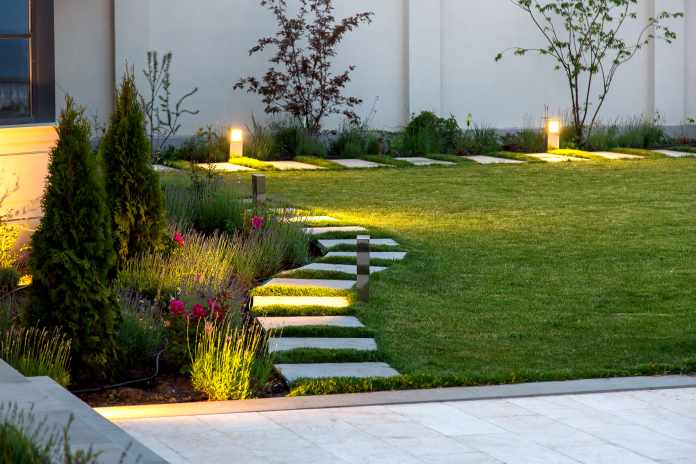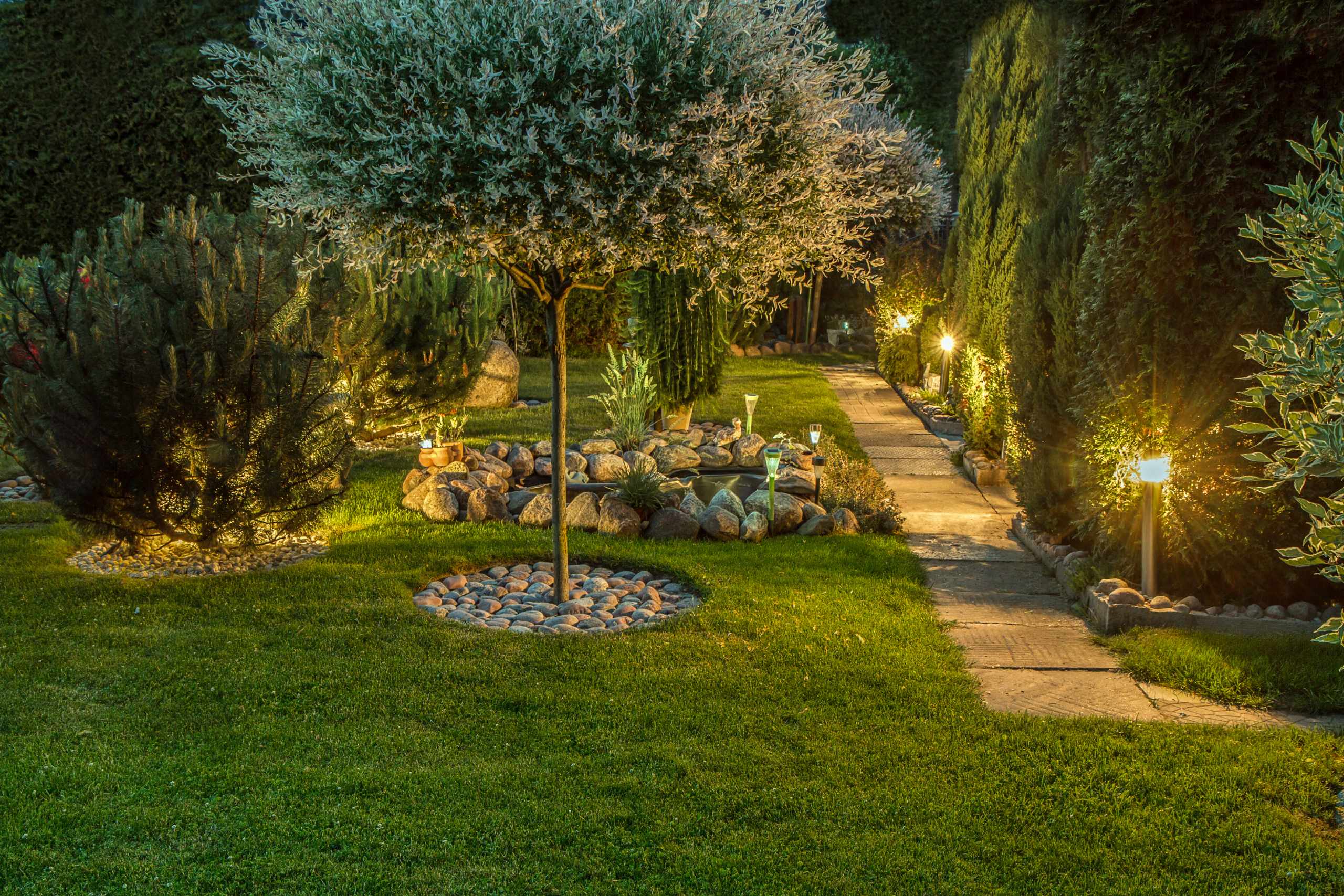
If you’re eager to upgrade your home’s curb appeal, you should consider investing in landscape lighting. The addition of lights is more than just highlighting trees or pathways. A well-designed lighting system in your outdoor space can help establish mood, along with security and safety. Creating the ideal landscape lighting for your outdoor space can boost its attractiveness, while also increasing the overall value of your property. The proper arrangement of the landscape lights will effectively make your property stand out from the rest. Whether you’ll work with a professional or eager to tackle landscape lighting yourself, here are some dos and don’ts of landscape lighting.
Table of Contents
Dos
-
Incorporate a combination of light intensities all over the outdoor space
When you use the same bright lights in all the fixtures, it can disrupt the overall depth and texture you’re planning to achieve, and your landscape will turn out flat. It’s best to utilize a variety of lights in various intensities and colors.
You can incorporate a combination of soft, warm colors in different areas around your property to create the ideal ambiance and depth. If you want to learn how to achieve the ideal Seattle Washington landscape lighting design for your home, utilizing various light intensities for the light fixtures is a good start.
-
Consider the role of shadows in your yard
You can establish an ideal atmosphere by utilizing an interplay of shadow and light. For example, when you have garden walls, you might consider using well lights at the base for illumination.
The combination of shadow and light on the façade of the wall can highlight the texture. Additionally, silhouetting a tree against the house façade, fence, or pool surface imparts depth to a flat surface.
-
Use good light fixtures in your outdoor space
Some homeowners often try to save on the costs by limiting the number of fixtures and compensating by increasing the brightness of the light bulbs. Sadly, doing this will only produce alternating areas of excessive brightness and darkness in your yard.
If you have a strict budget for your landscaping project, it’s best to install in phases, prioritizing the area around the house as a good start. This approach ensures that every area gets the look you want, along with a more manageable installation.
-
Provide proper lighting to trees
When illuminating a tree with light, make sure that you’ll cover both the canopy and its trunk. Focusing light only on the canopy will make the tree appear as if it’s a levitating cloud of leaves with an undesirable look.
-
Switch to LED lighting to lessen energy consumption
The latest LED light bulbs consume less energy than the older halogen counterparts. The LED bulbs can also last longer. Today, you can find LED light bulbs that generate the same soft, warm whites as the halogen bulbs.
-
Select fixtures that complement the exterior color scheme of your home
If your home has a combination of earth tones, as well as brown trims and embellishments, bronze usually works best. Generally, black is a suitable choice for most color schemes, while white fixtures are good on homes with dark-colored form and white trimming.
-
Follow a mounting height that is slightly above eye level
Always remember to stick with 66 inches above the threshold for the front of your home. Also check the exterior house color trends 2023 and revive your home with the popular home exterior paint choices.
-
Install post lanterns near the driveway
If the light from the garage or front door fixtures can’t reach the entire length of the driveway, you can consider adding post lanterns as a source of light for illumination.
-
Make the most out of multiple layers
One way to create a spotlight in your yard is to avoid arranging several fixtures close to each other. Instead, the best approach is to set several spotlights with varying angles toward a focal point, such as a topiary or statue you want to illuminate. It produces a dramatic effect that’ll reveal layers and silhouettes.
-
Add accent lights
If your yard has a few dark corners that you find unappealing, you can use accent lights. These lights can impart a touch of flair, while also keeping away potential intruders who typically hide in dark spots to stay unnoticed.
-
Arrange the lights on the patio or deck
If you have a patio or deck that lacks adequate lighting, it might be time to add life to the area. Adding several small fixtures with low wattage can help achieve a better look, while creating an attractive and inviting ambiance. You can unwind in your patio or deck while enjoying the lovely outdoors.
-
Update the lighting system with smart controls
Today, you might find lighting options with smart features. The smart control option is becoming an add-on for most landscape lighting systems. The attractive feature allows you to adjust the brightness of the lights with one push of a button. The technology will make the landscape lighting in your property easier to manage.
If you want the landscape lights to turn on and off automatically, there are lighting systems equipped with timers. It’s a convenient and hassle-free approach so your yard won’t be pitch black in case you forgot to turn on the outdoor lights. Depending on the brand you’re planning to buy, the technology can work wonders in making your outdoor space genuinely worthwhile.
-
Incorporate steel bollards as path lighting
If you haven’t heard about bollards before, they’re the posts where boats and ships tie up on the dock. Today, steel bollards are becoming popular in gardens since this type of lighting fixture provides functional light to pathways, while imparting a unique ambiance at the same time. Steel bollards add a touch of beauty that blends perfectly into the landscape design. Depending on the design, the fixtures cast a lovely shadow on the ground.
Don’ts
-
Illuminate only the patios, pathways, and trees
With this approach, you isolate these elements and end up surrounded by darkness. You can fix this problem by positioning lights at the borders of your property in trees and plant beds. The placement of the lights will help integrate these elements within the overall landscape design and add a sense of depth.
-
Add the same lighting to the pathways and staircases
It’s important to note that pathways are flat surfaces that don’t produce shadows. As for staircases, they generate shadows even with minimal lighting. If you’re going to position lights at the top of the stairs, it’ll make the landing and bottom part of the stairs challenging to see.
-
Utilize bullet lights on every aspect of the outdoor space
Most find bullet lights attractive due to their versatile nature, and you can readily fit them with various bulbs and beams. However, they function as spotlights. If you want to achieve the ideal landscape lighting for your property effectively, try to limit the bullet lights on corners and architectural elements. Additionally, it’s best to use soft wash lights for the facades.
-
Underlight the landscape elements
If you limit the light fixtures on the lawn statues, water elements, or arbors, it can produce undesirable shadows. You should utilize two lights with proper spacing to avoid this problem and ensure that the bulb intensity is low to prevent washing out the features.
-
Use solar lights
Remember that solar lights generate minimal light, and their functionality depends on the weather. If it’s been cloudy or rainy all day, your yard will have no lights. An alternative worth considering is installing low-voltage LED lights.

-
Select fixtures that are too small
Most homeowners make the mistake of choosing light fixtures that are too small.
-
Limit the light fixtures at the back door
Make sure that the entire outdoor space gets adequate illumination, including the rear door area. Although you’ll choose presentable lighting fixtures for the front door, those you’ll install in the back door should match with the overall lighting theme of your home.
-
Isolate sections of your outdoor space
Some homeowners find it challenging to decide on the yard sections to include in the landscape lighting plan. If you fail to plan out the design correctly, you can isolate some areas, such as the pathways and trees.
In most cases, these elements receive illumination, but if only these elements receive light, the surrounding area is left in the dark, resulting in an undesirable effect. The best way to avoid an extreme lighting contrast is integrating other sections of the landscape by positioning lights in the trees and plant beds on the outer edge of the property.
-
Place path lights in planter beds
In some houses, path lights are often in the wrong place. You might find path lights in the flower beds. Remember placing path lights in flower beds will not provide adequate lighting. Path lights lining the walkway provide functional lighting that allows you to navigate through your yard with ease.
Conclusion
A well-designed landscape lighting plan can work wonders in illuminating the best features of your outdoor space, while maintaining safety and security at the same time. With the correct lighting elements and arrangement, your outdoor space is something that you can be proud of while also boosting the value of your home. With the help of these landscape lighting dos and don’t tips, you can make your outdoor space memorable and stand out from the rest in no time.














